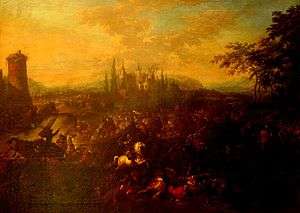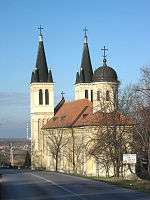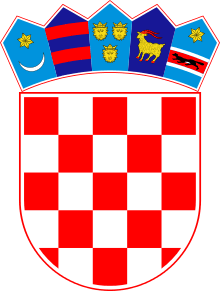Battle of Petrovaradin
The Battle of Petrovaradin or Peterwardein was a decisive victory for the Imperial Army of the Holy Roman Emperor in the war between the Archduchy of Austria of the Holy Roman Empire and the Ottoman Empire (1716–1718), at Petrovaradin (then part of Military Frontier, Archduchy of Austria; today part of Novi Sad, Vojvodina, Serbia).
| Battle of Petrovaradin | |||||||
|---|---|---|---|---|---|---|---|
| Part of Austro-Turkish War of 1716–18 | |||||||
 The Battle of Peterwardein on the 5th of August | |||||||
| |||||||
| Belligerents | |||||||
|
|
| ||||||
| Commanders and leaders | |||||||
|
Prince Eugene of Savoy Infante Manuel, Count of Ourém János Pálffy Charles Alexander, Duke of Württemberg | Silahdar Damat Ali Pasha †[3] | ||||||
| Strength | |||||||
| 70,000[4] |
70,000 regulars[5] Unknown auxiliaries[5] | ||||||
| Casualties and losses | |||||||
| 4,500 killed and wounded[5] |
6,000 killed[5] 172 cannons captured[5] | ||||||
History
In 1716, Grand Vizier Damat Ali gathered an Ottoman force of 70,000 regulars at Belgrade, at the core of which were 41,000 Janissaries and 30,000 provincial troops, along with Tatar and Wallachian auxiliaries.[6] They crossed the Sava at Zemun at the end of July, and moved on the right bank of the Danube towards Sremski Karlovci (in the Habsburg territory). The Tatars, with Moldavians and Kurucs drove into Transylvania, but the Transylvanian forces were no match for the Tatars.[7]
The commander of the Austrian forces, Prince Eugene of Savoy, decided to engage the Ottomans at Petrovaradin. He had arranged for the construction of a fortified encampment within the Petrovaradin fortress there, and set the 70,000-strong[4] Imperial army on the march from their quarters in Futog. There was an 8,000 man garrison in the fortress consisting primarily of Serbs.[8] In the Austrian army served Croatian and Hungarian infantry and cavalry regiments (approx. 42,000 men), Serbian border soldiers in the Vojvodina and the auxiliaries from Württemberg.[2]
On August 2, the first skirmish between the Imperial vanguard and Ottoman horsemen occurred. By the next day, the Grand Vizier had already reached Petrovaradin and immediately dispatched 30,000 Janissaries against the imperial positions. They dug saps and began to bombard the fortress.
The core of the Imperial army only crossed the Danube on the night of August 5 by two pontoon bridges after which they encamped.
Battle
On 5 August, Prince Eugene began the Austrian offensive. The Imperial left flank defeated the Janissaries in their trenches. The Janissaries counterattacked the disordered Habsburg right flank. János Pálffy's cavalry stopped the Janissaries and Habsburg infantry pushed the Turks back 5 kilometres.[5]
Prince Eugene launched a general attack on the Ottomans and the Ottoman cavalry fled the battle. The Janissaries were crushed and Damad Ali killed, along with 6,000 of his men.[5] He is buried at the Belgrade Fortress, Kalemegdan, in the tomb known as Damad Ali Pašino Turbe. Eugene wrote his report on the battle from Damad Ali's tent, reporting the seizure of 172 cannons, 156 banners and five horsetails.[5]
Aftermath
After Petrovaradin, Prince Eugene turned against Timișoara (in Ottoman territory) and the Ottomans surrendered on 16 October after a siege of 43 days.[5]
After the war, a church commemorating this event was built on Tekije, on the hill over battlefield, and is dedicated to Our Lady of Tekije, also known as Our Lady of the Snows. The church is special, because it has both Catholic and Orthodox altars and both Christian denominations use it. The site is a place of pilgrimage on every August 5.
At the place of the battlefield at the hill Vezirac in Petrovaradin the monument that honors the victory of Austrian army was erected in 1902. It was designed by Zagreb architect Herman Bollé.[9]
- Petrovaradin fortress, substantially rebuilt in the mid-18th century
 Church of St. Mary of the Snows
Church of St. Mary of the Snows Turkish state tent captured in the Battle
Turkish state tent captured in the Battle
See also
Notes
- Eugene, Prince of Savoy-Carignan, Spencer Tucker, A Global Chronology of Conflict: From the Ancient World to the Modern Middle East, Vol. II, ed. Spencer C. Tucker (ABC-CLIO, 2010), 820.
- A péterváradi csata (Bánlaky József: A magyar nemzet története)
- A Global Chronology of Conflict: From the Ancient World to the Modern Middle East, Vol. II, ed. Spencer C. Tucker, (ABC-CLIO, 2010), 721.
- Ágoston 2011, p. 103.
- Ágoston 2011, p. 104.
- Ágoston 2011, p. 102, 104.
- Magyarország története 1526-1686 (History of Hungary 1526-1686), Authors: Zsigmond Pach and Ágnes Várkonyi, Akadémia Kiadó (Akadémia Publisher), Budapest 1985. ISBN 963-05-4098-3
- "Vojvodina.com". Archived from the original on 2016-03-04. Retrieved 2008-06-16.
- Damjanovic, Dragan. "Javni spomenici, radovi zagrebačkih arhitekata, u Kupinovu, Novom Slankamenu i Vezircu kod Petrovaradina ( Public Monuments Built by Architects from Zagreb in Kupinovo, Novi Slankamen, and Vezirac near Petrovaradin )". Scrinia Slavonica : Godišnjak Podružnice Za Povijest Slavonije, Srijema I Baranje Hrvatskog Instituta Za Povijest, Nr. 10, Pages 226-243.
Sources
- Ágoston, Gábor (2011). "Punic Politics, Economy, and Alliances, 218–201". In Ingrao, Charles; Samardzi, Nikola; Pesalj, Jovan (eds.). The Peace of Passarowitz, 1718. West Lafayette, Indiana: Purdue University Press. ISBN 978-1-55753-594-8.CS1 maint: ref=harv (link)
- Petrovaradin, Enciklopedija Novog Sada, knjiga 20, Novi Sad, 2002
- Henderson, Nicholas. Prince Eugen of Savoy. Phoenix Press. 2002
- Zvonimir Vuković, Igor Novaković, Petrovaradin juče, danas, sutra; Novi Sad, 2005
- Marko Kljajić, Sveti Juraj u Petrovaradinu, Petrovaradin, 2004.
- Stari Novi Sad I, Književna zajednica Novog Sada, Novi Sad, 1991.
- Živko Marković, Novi Sad i Petrovaradin, Novi Sad, 1984.
- "Kulturno-privredni pregled Dunavske banovine" br. 5 i 6, Novi Sad, 1939.
- Nenad Šeguljev, Aleksandar Pavlović, Philip Wattles, Petrovaradin fortress - "Gibraltar on the Danube", Magazine "FORT" Volume 34, Gosport, Hampshire, UK, 2006,
- Liptai Ervin: Magyarország hadtörténete (Military history of Hungary), Zrínyi Katonai Kiadó (Zrínyi Military Publisher), Budapest 1985. 1985. ISBN 963-326-337-9.
- Magyarország története 1526-1686 (History of Hungary 1526-1686), Authors: Zsigmond Pach and Ágnes Várkonyi, Akadémia Kiadó (Akadémia Publisher), Budapest 1985. ISBN 963-05-4098-3.
- Elezović, Dalibor M. (2016). "Vesti o Bici kod Petrovaradina i opsadi Beograda u autobiografskim spisima Žana Frederika Dizbaha". Zbornik Radova Filozofskog Fakulteta U Prištini. 46 (3): 53–63. doi:10.5937/zrffp46-12090.
- Attribution: The information in this article is based on and/or translated from its German equivalent.


